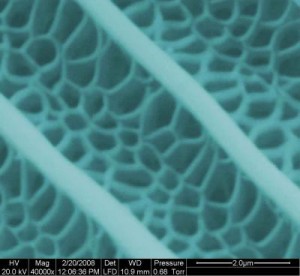Researchers replicate butterfly wings on a nano-scale

A cross-national team of researchers have developed a technique to replicate biological structures, such as butterfly wings, on a nano-scale.
The new bio-material could be used to make optical devices, such as optical diffusers for solar panels or coverings that maximize solar cell light absorption.
Researchers from the State University of Pennsylvania and the Universidad Autónoma de Madrid (UAM), Spain developed a fabrication technique to develop wings at the nano-scale level that could replicate the optical responses of butter?y wings. The replicas contain light emitting properties similar to those of insects, mimicking the colors, iridescence (the ability to change colors depending on the angle) and the metallic appearance which is visible with a changing viewing angle.
According to the researchers, they fabricated the butterfly wing by using a coating made of compounds based on Germanium, Selenium and Stibium (GeSeSb) and a technique called Conformal-Evaporated-Film-by-Rotation (CEFR), which combines thermal evaporation and substrate rotation in a low pressure chamber.
Key to the process was the use of a bio-template, which was an actual butterfly wing. After it was coated with the GeSeSb material, they had to immerse the wing in an aqueous orthophosphoric acid solution to dissolve the chitin ( a substance typically found in the exoskeleton of insects and other arthropods). The free-standing replica left behind was undamaged by the dissolution process.
Until now, the methods used to replicate bio structures are very limited when it comes to obtaining effective copies on a nanometric scale, say the researchers. Citing that they often damage the original biostructure because they are used in corrosive atmospheres or at high temperatures. "The new technique 'totally' overcomes these problems, as it is employed at room temperature and does not require the use of toxic substances," they said.
The scientists have presented their findings in the journal Bioinspiration & Biomimetics, and their paper, "Fabrication of free-standing replicas of fragile, laminar, chitinous biotemplates", can be downloaded here (PDF, 418KB).
The image to the right shows the uncoated wing (left), a coated wing (middle) and a free-standing replica (right). The coating and, therefore, the replica are made of GeSbSe chalcogenide glass. (Unfortunately, a fraction of the replica partially broke off and curled up during handling, the researchers said.)
The practical applications of the discovery are wide-ranging. In addition to optical devices, the technique can be used to replicate other biological structures, such as beetle shells or the compound eyes of flies, bees and wasps, said Raúl J. Martín-Palma, a lecturer at the Department of Applied Physics of the UAM and co-author of the study.
According to Martín-Palma, the compound eyes of certain insects are sound candidates for a large number of applications as they provide great angular vision. "The development of miniature cameras and optical sensors based on these organs would make it possible for them to be installed in small spaces in cars, mobile telephones and displays, apart from having uses in areas such as medicine (the development of endoscopes) and security (surveillance)," he said.
